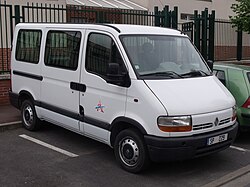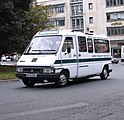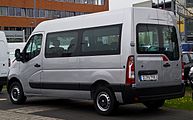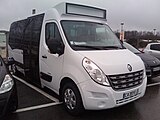Renault Master
| Renault Master | |
|---|---|
| Manufacturer: | Renault |
| Production period: | 1980 – today |
| Previous model: | Renault Estafette |
| Successor: | none |
The Renault Master is a medium-sized van from Renault . Due to the Renault-Nissan corporate relationship , the second generation Master is built as the Nissan Interstar and the current model as the Nissan NV400 .
In addition, the Master has been developed and produced together with General Motors Europe since the second generation . The Vauxhall / Opel Movano emerged from this cooperation . The Renault Master II won the Van of the Year title in 1998 .
Master I (1980–1997)
| Master I. | |
|---|---|

Renault Master I (1980-1994) |
|
| Production period: | 1980-1997 |
| Designs: | Panel vans , flatbed trucks , minibuses |
| Engines: |
Gasoline engines : 2.0–2.2 liters Diesel engines : 2.1–2.5 liters |
| Length: | 5000 mm |
| Width: | 2000 mm |
| Height: | 2415 mm |
| Wheelbase: | 2870-3700 mm |
| Payload: | 1.67 t |
As the successor to the Renault Estafette , the Renault Master came onto the market in the summer of 1980 together with the Renault Trafic and is designed for the larger gross vehicle weight class from 2.8 to 3.5 tons.
The Master was manufactured in the SoVAB ( Société des Véhicules Automobiles de Batilly ) plant in the Meurthe-et-Moselle department , which opened in 1980 , where some variants of the Trafic later rolled off the assembly line. The first series was characterized by a sloping bonnet that merged into the windshield without a kink. The circular door handles fitted smoothly into the body surface were also noticeable. At that time, the front-wheel drive with longitudinally installed engines was unusual in the segment , which resulted in a high position of the driver's cab.
The Master was available with three different wheelbases (2.87, 3.23 and 3.70 m) and as a minibus , panel van , flatbed truck , minibus and chassis for bodies. The gross vehicle weight was 2.8, 3.0, 3.1 and 3.5 tons. There were two different roof heights. A maximum of 9 to 12.7 m³ could be loaded into the van. A 2.0 l petrol engine with 59 kW / 80 hp from the Renault 20 or a 2.55 l diesel engine with 52 kW / 71 hp was used as the drive . This engine came from Fiat- SOFIM , in which Renault was involved at the time, and was also installed in the contemporary Iveco Daily and Fiat Ducato . The Master was also optionally available with rear- wheel and all-wheel drive . These versions with partly higher payloads were offered as Renault Messenger and replaced the Renault Super Goélette SG2 .
In 1984 there was also a 2.1 l diesel engine with 44 kW / 61 hp and a 2.2 l petrol engine with 66 kW / 90 hp.
In 1989 the revised SOFIM diesel engine with now 55 kW / 75 PS and with a turbocharger 65 kW / 88 PS came into the range. From 1990 onwards it produced 69 kW / 94 PS.
In mid-1994 there was a slight facelift and the turbodiesel engine was now also available with a catalytic converter and 66 kW / 90 hp, while the 2.2-liter petrol engine now developed 75 kW / 101 hp.
At the end of 1997, production of the first Renault Master was stopped. In the 1980s in particular, it was also very successful in exports due to the many possible variations in construction, weights and drive options.
Master II (1997-2010)
| Master II | |
|---|---|

Renault Master II (1997-2003) |
|
| Production period: | 1997-2010 |
| Designs: | Panel vans , flatbed trucks , minibuses |
| Engines: |
Diesel engines : 1.9-3.0 liters (59-107 kW) |
| Length: | 4899-5899 mm |
| Width: | 1990-2361 mm |
| Height: | 2053-2717 mm |
| Wheelbase: | 3078-4078 mm |
| Payload: | 1.45-2.1 t |
Development of the new Renault Master started in 1987, but was stopped again because of the high costs.
In 1989 Renault came to an agreement on the joint development of a van with Leyland DAF , which needed a successor to the Daf 400 , and development has now been resumed together. After Leyland DAF went bankrupt in 1993, Renault took over the entire development process itself.
In 1995 Renault signed an agreement with Iveco to develop a cab for the Master II, Mascott and Iveco Daily III models . Due to the rising cost of the project, Renault decided to look for another partner, which was found in General Motors Europe in 1996 . It was agreed to have Renault commercial vehicle models offered by GM brands Opel and Vauxhall using badge engineering . The first result of this cooperation was the Vauxhall / Opel Arena .
The joint development project of the three car manufacturers was completed at the end of 1997 with the presentation of the Master II, in mid-1998 with the presentation of the Opel Movano A and in 1999 the presentation of the Iveco Daily III and Renault Mascott (successor to the Messenger).
In 1998 the Renault Master won the Van of the Year title . In addition to the versions already known from the predecessor, there was now a minibus ex works with 16 seats. The loading volume of the panel van was now 8 to 13.9 m³. There was only front-wheel drive, the rear-wheel drive variants were reserved for the Renault Mascott. Only diesel engines were used as engines. At the start of production, these were a SOFIM 2.5 liter diesel engine with 59 kW / 80 PS and a 2.8l dTi with 84 kW / 115 PS. Later a 1.9l dTi with 59 kW / 80 PS developed by Renault itself was added. Even in the development phase, environmental considerations were taken into account, with the result that almost 90% of the Master’s materials can be recycled. In order to minimize costs for the consumer, the lower body panels, which are often the victim of road damage, were pressed separately and made easily replaceable by screwing on / unscrewing.
In 2000/2001, Renault introduced newly developed dCi engines with common rail injection . The 1.9 dTi was replaced by the 1.9 dCi with now 60 kW / 82 PS, the 2.5 from the 2.2 dCi with now 66 kW / 90 PS and the 2.8 dTi by the 2.5 dCi with 84 kW / 115 PS replaced. 1999 began Renault-Nissan - Alliance . Therefore, from the beginning of 2002, various Renault transporters were also offered under the Nissan brand . A second sister model was added to the Master II from the beginning of 2002 with the Nissan Interstar .
The Renault Master (and its sister models) underwent a major overhaul in autumn 2003. In terms of design, the front and the interior have changed, and the chassis has also been improved. The 1.9 dCi engine has also been revised. A new addition was a 3.0 dCi with 100 kW / 136 PS from Nissan, which was also installed in the Nissan Patrol . ESP ( vehicle dynamics control ) was now optionally available for the revised model . From now on, a brake assistant was also part of the series standard in addition to the anti-lock braking system that was already installed . In addition to the manual five-speed transmission, an automated manual transmission called Tec-Shift was now also available.
In the following years the engine range changed due to the further development of the 2.5 dCi. A 74 kW / 100 PS variant replaced the 2.2 dCi, the 84 kW / 115 PS variant rose to 88 kW / 120 PS. The 3.0 dCi was replaced by the 2.5 dCi with 107 kW / 145 PS.
Master III (since 2010)
| Master III | |
|---|---|

Renault Master III (2010-2014) |
|
| Production period: | since 2010- |
| Designs: | Panel vans , flatbed trucks , minibuses |
| Engines: |
Diesel engines : 2.3 liters (74–132 kW) Electric motor : |
| Length: | 5048-6848 mm |
| Width: | 2070 mm |
| Height: | 2307-2815 mm |
| Wheelbase: | 3182-4332 mm |
| Payload: | 0.685-2.321 t |
| Perm. Total weight: | 2.8-4.5 t |
The third generation Renault Master debuted in spring 2010, replacing both the second generation Master and the Renault Mascott . As a result, as in the first generation, the Master III is again available with either front or rear-wheel drive. As a front-wheel drive vehicle it is available in the weight classes 2.8, 3.3 and 3.5 tons, as a rear-wheel drive vehicle with a total weight of 3.5 or 4.5 tons. The rear-wheel drive 3.5-tonner can optionally be equipped with twin tires, which is standard on the 4.5-tonner.
A new 2.3 l dCi engine is used as the drive. Originally there were three power levels between 74 and 110 kilowatts, later four or five power levels between 81 and 132 kilowatts. The weakest engine in each case is only supplied for front-wheel drive or a maximum total weight of 3.5 tons. It is shifted by means of a six-speed gearshift or, in the case of the 125 kilowatt engine, optionally also with an automated manual transmission.
The front-wheel drive vehicles can tow 2.5 tonnes, the rear-wheel drive vehicles with double tires 3.5 tonnes, the gross vehicle weight is limited to 7.5 tonnes. Since September 2013, the Master III with rear-wheel drive can again be ordered with switchable all-wheel drive , this system is additionally coupled with a reduction stage (1: 1.42), which enables slow driving in difficult terrain or with heavy loads.
This generation of the Master was again developed together with GM / Opel / Vauxhaul. In addition to the Opel Movano B, the Nissan NV400 is also a sister model of the Master III.
1. Facelift
In 2014 the Master III got a small facelift, which included a revised infotainment system and a new grille. A reversing camera is now also available as an option, otherwise the master remained unchanged.
Master ZE
The all-electric version was presented in spring 2017 and was available in Germany as the Master ZE from summer 2018. The electric motor has an output of 57 kW or 77 hp.
2. Facelift
An extensive facelift of the Master III was presented on April 23, 2019 and will be available in Germany in the fourth quarter of 2019. The following components have been revised:
- Design of the front
- New interior (dashboard, steering wheel)
- New infotainment
- New, most powerful diesel engine 2.3 dCi with 132 kW / 180 PS
- All engines meet the Euro 6d-temp standard or Euro VI for truck approval
- New assistance systems such as crosswind assist or blind spot warning
The sister model Opel Movano also got the facelift, although Opel / Vauxhaul has been part of the French competitor PSA since 2017 .
Technical specifications
| model | dCi 100 | dCi 110 | dCi 125 | dCi 130 | dCi 145 | dCi 150 | dCi 165 | dCi 170 | dCi 180 | ZE |
|---|---|---|---|---|---|---|---|---|---|---|
| construction time | 2010- | 2010- | 2010- | 2017- | ||||||
| Number of cylinders | 4th | - | ||||||||
| Displacement (cm³) | 2298 | - | ||||||||
| Max. Power (kW / PS) | 74/100 at 3500 min -1 |
77/110 at 3500 min -1 |
92/125 at 3500 min -1 |
99/135 at 3500 min -1 |
107/145 at 3500 min -1 |
110/150 at 3500 min -1 |
120/163 at 3500 min -1 |
125/170 at 3500 min -1 |
132/180 at 3500 min -1 |
57/77 |
| Max. Torque (Nm) | 285 at 1250 to 2000 min -1 |
290 at 1500 to 2250 min -1 |
310 at 1250/1500 to 2500 min -1 |
330 at 1250/1500 to 2500 min -1 |
360 at 1500 to 2500 min -1 |
350 at 1500 to 2750 min -1 |
380 at 1500 to 2750 min -1 |
380 at 1500 to 2750 min -1 |
400 at 1500 to 2750 min -1 |
- |
| transmission | 6-speed manual transmission | 6-speed manual or automated | - | |||||||
| Comb. Consumption NEDC (l / 100 km) | 7.5-8.6 | 7.4 | 7.7-9.9 | 7.7-9.3 | 6.3-8.6 | 8.5-9.9 | 7.5-8.6 | 6.3-7.1 | 5.3-7.1 | - |
| Range (km) | - | 120 | ||||||||
In December 2010, the model was recalled due to problems with the rear axle and insufficient hold of the seat belts.
Individual evidence
- ^ Transporter: Renault Master with all-wheel drive. Transport, the newspaper for freight transport, September 2, 2013, accessed on July 17, 2020 .
- ↑ a b c d e Renault: Renault Master, model year 2017. Accessed November 21, 2017 .
- ^ Opel and Renault: Recall of Transporter Movano and Master ( Memento from April 7, 2013 in the Internet Archive )
Web links
- Technical data for the Renault Master II (after facelift; PDF; 264 kB)
- Official website of the Master III panel van
- 25 years of Renault Master









